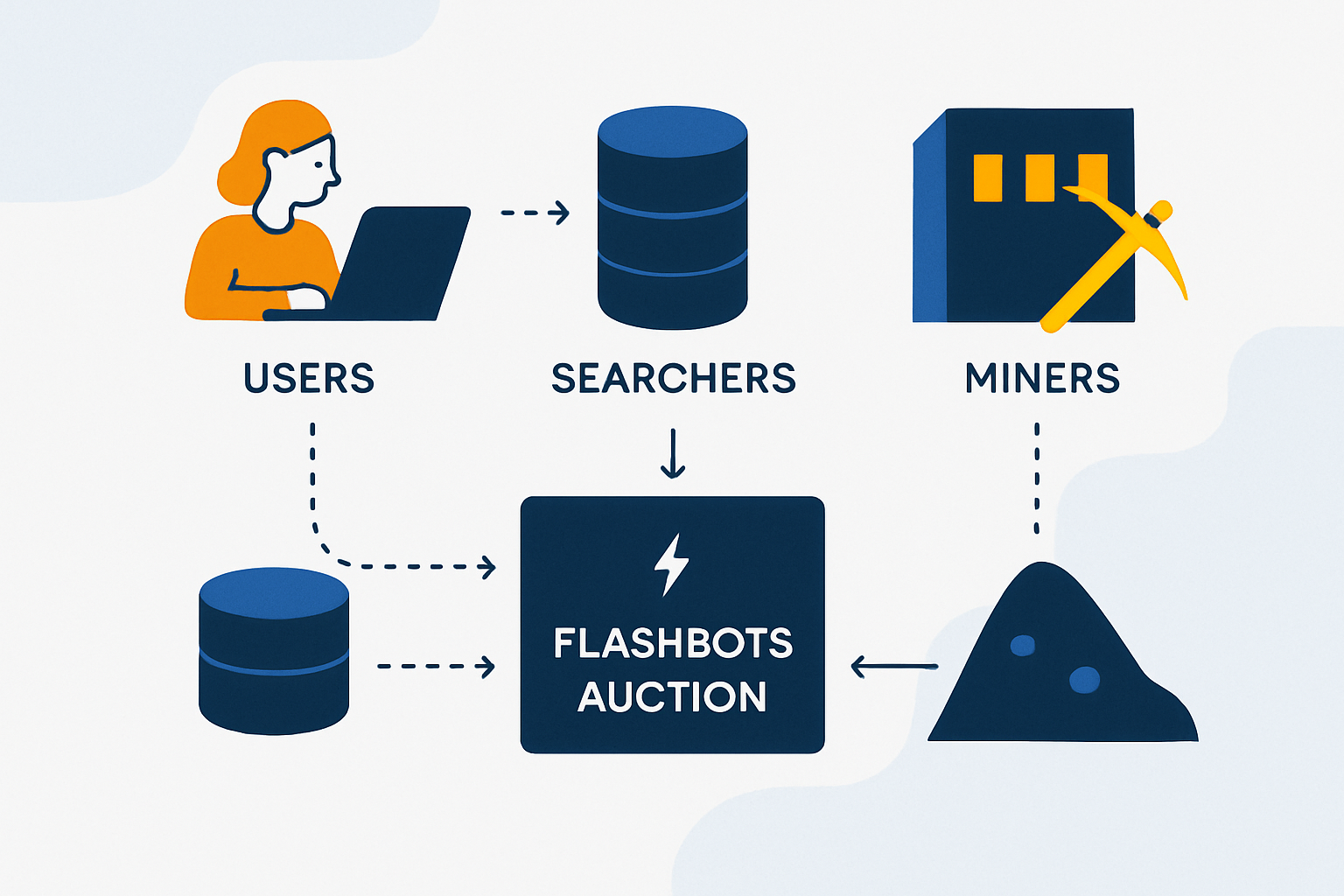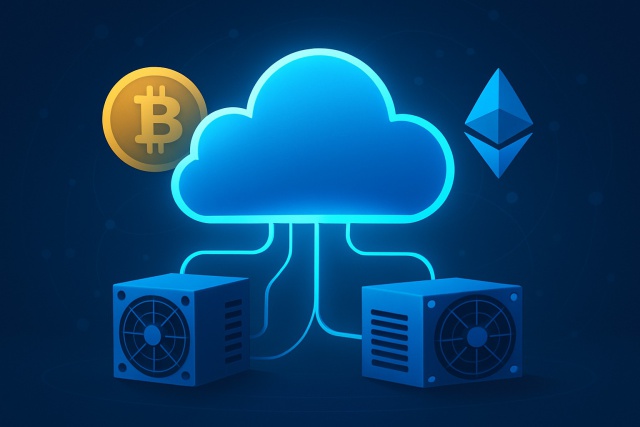Flashbots Explained for Beginners


Flashbots is a groundbreaking project within the Ethereum blockchain that tackles a tricky but key challenge known as Miner Extractable Value (MEV). If you’re new to the space, terms like front-running and transaction ordering might feel a bit like jargon thrown around at a busy market stall. Flashbots aim to cut through that noise, making the whole process clearer and fairer by shaking up how transactions are handled.
Getting to Grips with the Basics of Flashbots
Miner Extractable Value (MEV), which is the extra profit miners or validators can squeeze out by reshuffling or prioritizing certain transactions. Picture a hectic checkout line where the cashier lets some customers jump ahead just because they flash a few extra bucks — MEV is trying to put a stop to this kind of unfair play in how Ethereum handles transactions.
- Flashbots is a research and engineering team tackling the tricky MEV problem on Ethereum.
- Miner Extractable Value (MEV) occurs when miners or validators find ways to shuffle or sneak in transactions to line their pockets.
- MEV tips the scales unfairly, pushes up fees, and disrupts the network’s smooth operation.
- Ethereum transactions are lined up in the open mempool, making them vulnerable to manipulation.
- Flashbots offers a private and transparent channel for transaction bundles to reduce MEV risks and make processing fairer, giving everyone a better shot at a level playing field.
Why MEV Really Matters and the Headache Flashbots Aim to Fix
MEV stands for the sneaky profits that miners or validators can grab by rearranging the order of transactions or slipping their own ahead of others. This often sparks nasty behavior like front-running or sandwich attacks that chip away at user trust and hike costs. Sometimes it even throws a wrench into the smooth running of decentralized finance (DeFi) markets.
- Front-running happens when a miner slyly slips their transaction ahead of someone else's and grabs a juicy advantage from early insight, kind of like jumping the queue right before a big trade.
- Back-running means firing off transactions immediately after a specific one to try and ride its wave to profit.
- Sandwich attacks are a crafty move where a trader places a victim’s transaction between two of their own, nudging prices just right to walk away with a neat gain.
- These sneaky tactics cause unpredictable costs and create a pretty unfair playing field, which can really chip away at people's trust in the network.
- MEV extraction isn’t just a headache for fairness, it can also threaten Ethereum’s security by tempting miners to play dirty instead of sticking to honest behavior.
Clearing Up the Confusion
A lot of newcomers often jump to the conclusion that MEV is all bad news and that Flashbots just open the door to shady manipulation. But here’s the thing. MEV is actually a natural part of how blockchain transactions get lined up. Depending on how it is handled, it can be either harmful or helpful. Flashbots isn’t some shady scheme to promote cheating. Instead, it provides transparent tools designed to reduce the nasty side effects.
- MEV is not just a pesky downside. It is a fundamental part of how blockchain works and needs thoughtful handling instead of being swept under the rug.
- Flashbots don’t let anyone cheat the system. They provide a fairer behind-the-scenes way to ease the cutthroat race between transactions.
- Flashbots are designed to be decentralized and open-source so they definitely are not about central control calling all the shots.
- You cannot stop MEV extraction. With the right approach, it can become more transparent and far less damaging.
- Flashbots shine a brighter light by openly sharing the strategies MEV searchers use and explaining how the value gets redistributed.
How Flashbots Work
Flashbots operates through a private communication channel where a select group of individuals called "searchers" send transaction bundles directly to miners or validators instead of tossing them into the public mempool. This clever setup helps fine-tune which transactions make the cut and when, encouraging a fairer spread of value.
Users and decentralized applications spot transactions with MEV potential and send them off to searchers or directly through the Flashbots network like passing a hot potato that everyone wants a bite of.
Searchers dive into the mempool and blockchain state to carefully craft optimized bundles of transactions designed to squeeze out as much MEV as possible while avoiding too much chaos.
These bundles get sent privately to miners or validators via the Flashbots Auction relay, sidestepping the noisy public mempool where things can get messy.
Miners pick the bundles offering the juiciest rewards and include them in newly minted blocks while prioritizing transactions fairly.
The rewards from MEV extraction are shared transparently among miners, searchers and sometimes users, keeping everyone’s incentives in sync and the system humming along.

Traditional Ethereum transactions typically land in the public mempool, open for anyone to peek at and potentially take advantage of. Flashbots flips the script by using a private channel known as the Flashbots Auction. This clever tweak helps dial back harmful competition and frontrunning.
How Flashbots Can Actually Make Life Easier for Ethereum Users and Developers
- Front-running and sandwich attacks, along with other exploitative tactics, get noticeably trimmed down, letting users enjoy a much fairer shot at their transactions.
- Transaction inclusion becomes more predictable and less like a game of chance. This is a win-win for traders and dApp users alike.
- Flashbots shines a light on MEV extraction by making bundles and their outcomes public, building trust in the network.
- The incentives between miners, searchers and users line up much better, cutting down on the chance of any nasty behavior.
- Gas fees wasted on transactions competing against each other take a nosedive because Flashbots bundles them more efficiently, saving money and easing network congestion.
Flashbots has truly been a game-changer in putting the brakes on many common DeFi exploits. It lets traders go big with their orders without losing sleep over sneaky sandwich attacks or those pesky front-running bots.
Getting Started with Flashbots A Beginner's Guide That Will not Leave You Scratching Your Head
People curious about Flashbots can jump in from different angles depending on where they fit in the ecosystem. Users often lean towards wallets or interfaces that support Flashbots seamlessly. Developers usually roll up their sleeves to integrate Flashbots RPC endpoints for submitting bundles straight to the source. Miners, on the other hand, typically run Flashbots clients to snatch MEV in a fair and square way.
- When possible, lean on wallets that support Flashbots to send your transactions straight through the Flashbots relay— it’s a clever way to sidestep the public mempool chaos.
- For the developers out there or anyone needing programmatic access, submitting transaction bundles via Flashbots’ RPC endpoints is the way to go.
- Keep your finger on the pulse of MEV opportunities and pricing by checking out the dashboards and analytics tools generously shared by the Flashbots community—it’s worth bookmarking.
- Miners or validators can tap into Flashbots software to receive and manage private bundles, which usually means a fairer boost in revenue—not too shabby.
- Developers should proceed with caution: carefully follow the official documentation and run thorough tests before rolling out dApps integrated with Flashbots to make sure MEV handling stays rock solid and secure.
Important Precautions and Considerations You’ll Want to Keep in Mind
Flashbots definitely bring some clear advantages to the table but it really hinges on miners or validators actually opting in. Without broad buy-in, its impact tends to fall a bit flat. There is also the ever-present worry about centralization—those private MEV channels can easily end up putting too much power in just a few hands.
Looking Ahead at Flashbots and MEV in the Cryptocurrency World Next on the Horizon
Research on MEV is still very much a work in progress, with Flashbots pushing the envelope through advanced protocols like MEV-Boost that connect MEV-aware block proposals directly to Ethereum's consensus layers.
Flashbots fits neatly into Ethereum's long-term vision by championing decentralization and improving security through fair incentives. It also brings a welcome dose of transparency to how transactions get ordered.
Addressing MEV head-on with tools like Flashbots is absolutely vital for nurturing sustainable growth in DeFi. It benefits everyone involved by curbing exploitative shenanigans and fostering a fairer playing field—something that is really key to holding up Ethereum’s promise of being a truly decentralized platform. In my experience, tackling these issues transparently makes all the difference.
Frequently Asked Questions
Is Flashbots only beneficial for miners, or do regular users gain advantages too?
Flashbots brings perks to almost everyone involved in the Ethereum ecosystem. Regular users usually face fewer front-running attacks and enjoy lower fees due to fewer failed transactions. They also benefit from fairer trade execution overall. On the flip side, miners earn MEV rewards in a way that is much more transparent. Developers are not left out because they get access to handy tools that help build safer dApps using Flashbots' private transaction channels.
Does using Flashbots guarantee my transaction will be included in the next block?
While Flashbots can’t promise your transaction will be included in the very next block, it makes inclusion much more predictable. Miners tend to pick bundles that offer the best value so transactions with competitive fees or attractive MEV opportunities get an advantage. One huge benefit is avoiding the chaotic public mempool race which lowers your chances of being front-run, something many users surely appreciate.
Can Flashbots be used with any Ethereum wallet, or do I need special software?
To use Flashbots, you’ll want wallets or interfaces that work well with the Flashbots relay. MetaMask configured with specific RPC settings is a popular choice. Some DeFi platforms include built-in Flashbots integration which is quite handy. If you are unsure, checking your wallet’s documentation or trying tools like MEV-Inspect can reveal more options and save you some guesswork.
Does Flashbots eliminate MEV entirely, or just reduce its negative effects?
Flashbots doesn’t eliminate MEV completely because that would be like trying to fight gravity. MEV is a natural part of how blockchains operate. Instead, Flashbots focuses on reducing harmful effects by cutting down on things like sandwich attacks. By bringing transparency to MEV extraction and aligning everyone’s incentives, it decreases exploitative behavior while still letting miners and searchers earn profits in a fairer way.
Is Flashbots a centralized solution, and does it conflict with Ethereum’s decentralization goals?
Flashbots is open-source and designed to distribute MEV management rather than concentrate it in one place. While private channels might cause some concern about centralization, Flashbots addresses this by publishing bundle data on-chain and encouraging wide participation from miners, searchers and users alike. So, it’s not some exclusive club.
How does Flashbots interact with Ethereum’s shift to proof-of-stake (PoS)?
Flashbots has adapted alongside Ethereum’s move to PoS by using tools like MEV-Boost. This gives validators a fair chance at MEV opportunities while avoiding centralized choke points. Since the Merge, it has worked behind the scenes to ensure MEV remains fairly distributed across the network and keeps Ethereum’s core values of security and decentralization front and center.
Start Your Crypto Journey with Coinbase Today
Ready to enter the cryptocurrency market but unsure where to begin? Coinbase makes buying, selling, and storing digital assets simple and secure for beginners and experts alike.








